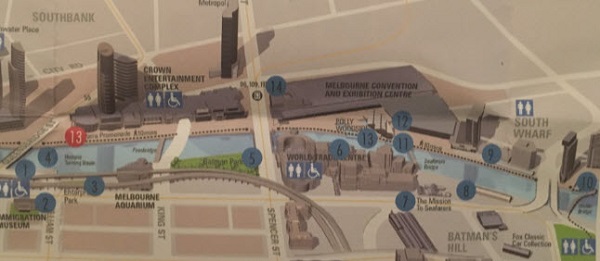Melbourne City Maritime Trail (Central Melbourne)

Melbourne's Yarra River Precinct is tailor-made for short, interesting walks on its three great themes: the arts, maritime heritage, and gardens. Each walk is about 90-120 minutes duration, although the wealth of attractions and points of interest along the way can easily fill-in many hours or an entire day.
The Yarra River Precinct is the hub of Melbourne's artistic and cultural scene. Probably nowhere in the world is there such a concentration of high quality visual and performing arts venues, quite apart from a very generous sprinkling of public art and the exciting architecture on display.
For the Melbourne Maritime Arts Trail, start at the city end of Queens Bridge (1889), which is reached by a 10 minute walk along Flinders Street from Federation Square, or take the free city tram to Market Street Stop 3.
Map with highlighted locations:

1 Enterprize Park is the site of the 1834 European landing in Melbourne and was the heart of Melbourne's 19th century river trade. The cut-away section of river is known as 'The Turning Basin', where sailing ships could turn around to return to the bay. The reconstructed Wharf and five figureheads known as 'Constellation' evoke the spirit of the early sailing ships.
2 Former Customs House (1876) is where goods entering the colony were assessed for their value and customs duties paid. It is now the Immigration Museum. (Open daily).
3 Scar Poles. An art installation created by eight indigenous artists, depicting the significance of the river bank and the water to the original inhabitants.
4 Yarra Falls. This section of the river used to mark the demarcation of salt water from the bay and the fresh water of the river. Aboriginal people were able to walk across the cascading falls on a rocky ledge until it was blasted away in the 1880s for the construction of Queens Bridge.
Walk past the Melbourne Aquarium (open daily), over King Street at the traffic lights, then through Batman Park, which commemorates John Batman, one of the founding fathers of Melbourne.
5 Spencer Street Bridge. Until opened in 1930, motorists had to use a punt to cross the river to enter South Melbourne.
6 WTC North Wharf is the water edge of the massive World Trade Centre complex (built 1983). Enter the Wharf Hotel (open daily) to admire the photographic wall murals depicting the early days of maritime trading at Australia Wharf, formerly located at this site.
7 Mission to Seafarers Building. The organisation has served the maritime community since 1857, but this distinctive Arts & Crafts style building dates from 1917. Open daily for free inspection. Don't miss the charming St Peter the Mariner chapel and the domed seafarers' gymnasium.
8 North Wharf cargo sheds and historic crane (no entry). The wharf dates from 1855 and is the lost intact example of an integrated wharf-shed-crane berth in the Port of Melbourne.
Cross the Seafarers Bridge (2009) to enter South Wharf Precinct, famous for the Melbourne Convention and Exhibition Centre, DFO shopping and its intimate promenade of riverside restaurants and cafes.
9 South Wharf. Between 2005 and 2011 a group of leading Australian heritage architects and designers rebuilt and raised the dilapidated wharf. The former cargo sheds date from 1884, but have been restored to what they looked like during South Wharf's boom maritime years of 1920-1940. Wander the Promenade and Dukes Walk to experience the variety of quality dining and hospitality venues. Some of them display original artefacts and fittings from that era.
Wander under the Charles Grimes Bridge to discover Melbourne's inner city marine village...
10 Yarra's Edge Marina and the ultra-modern Webb Bridge, which depicts the eel nets used by the river's earliest inhabitants. This area was once the Interstate Swinging Basin for the Port of Melbourne. Great views of the CBD skyline.
Retrace your steps back along the Promenade to...
11 Tall Ship Polly Woodside (1885) and Melbourne's Maritime Heritage Museum. The Polly sailed the world's oceans from the 1880s to the 1960s, before it underwent a full restoration for the National Trust by volunteers. Hop aboard to experience life under sail. See front entrance for opening hours.
12 Pump House display. The cut-away building and equipment from South Wharf's early days is open for external inspection all hours.
13 The Boatbuilders Yard. The location of this heritage cargo shed and outdoor hospitality area was the bustling scene of ship repair at the Duke and Orr's Dock between 1876 and 1975.
Conclude your journey by walking along the wooden walkway on the southern bank, admiring the views of modern Melbourne, but reflecting on the toughness of life for maritime workers in this area during the 19th and 20th centuries. As you cross over Clarendon Street to Crown, look right to view...
14 The Tea House. This beautiful six storey brick building was built in the 1880s to store chests of tea from around the world.
The Crown Promenade was also once part of the cargo facilities and maritime activity that stretched for five kilometres along the riverbank downstream of Queens Bridge. Continue to Queensbridge Street, where you can cross over the bridge to catch a tram back into the city, or continue your stroll along Southbank to Princes Bridge (1888).
This brochure "Melbourne City River Trails" is available at the Melbourne Visitor Centre at Federation Square.
Web Links
→ Melbourne City Arts Trail
→ Melbourne City Gardens Trail
→ Melbourne City Sports Trail








